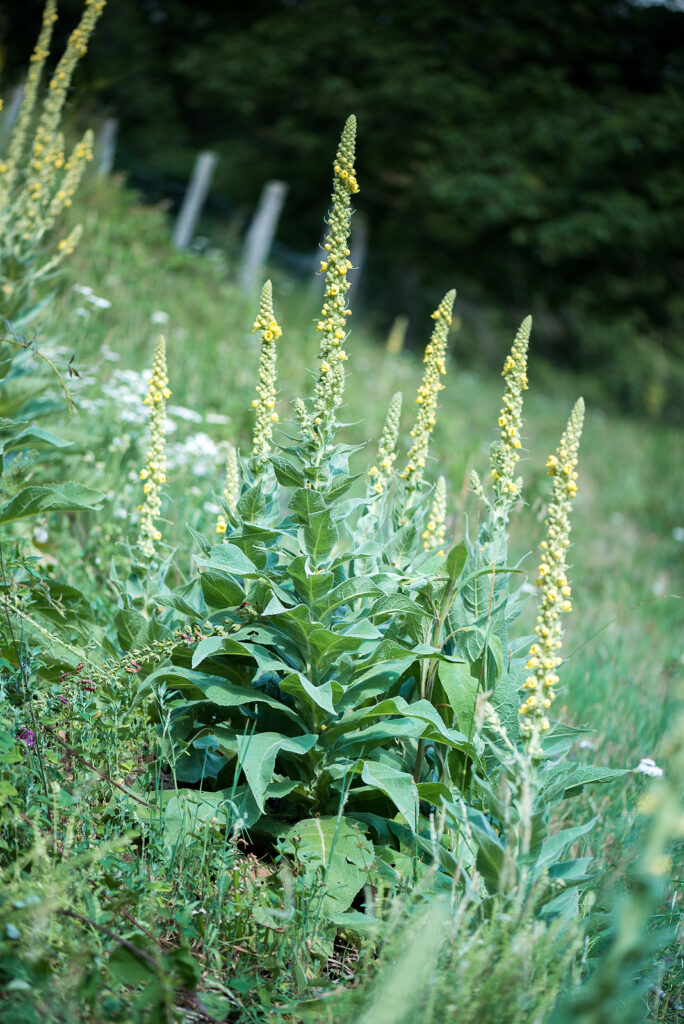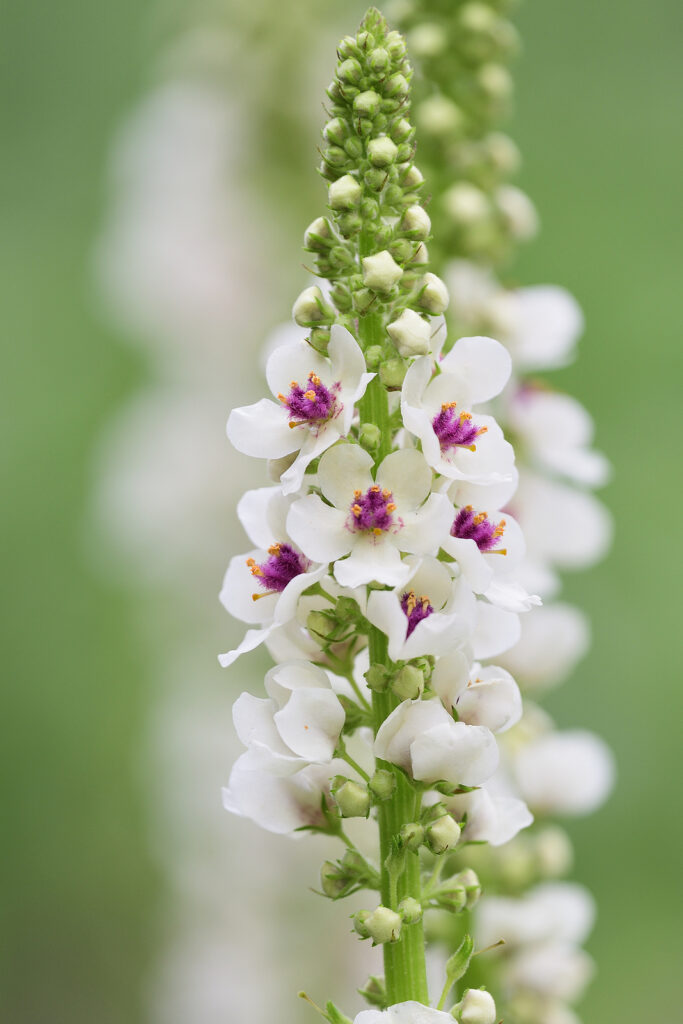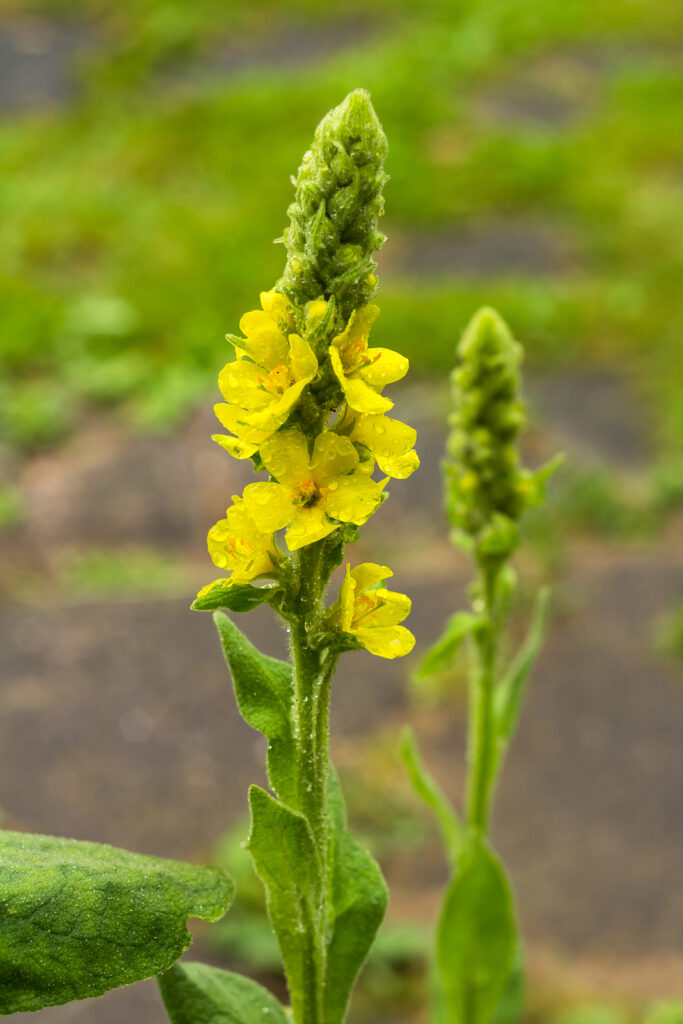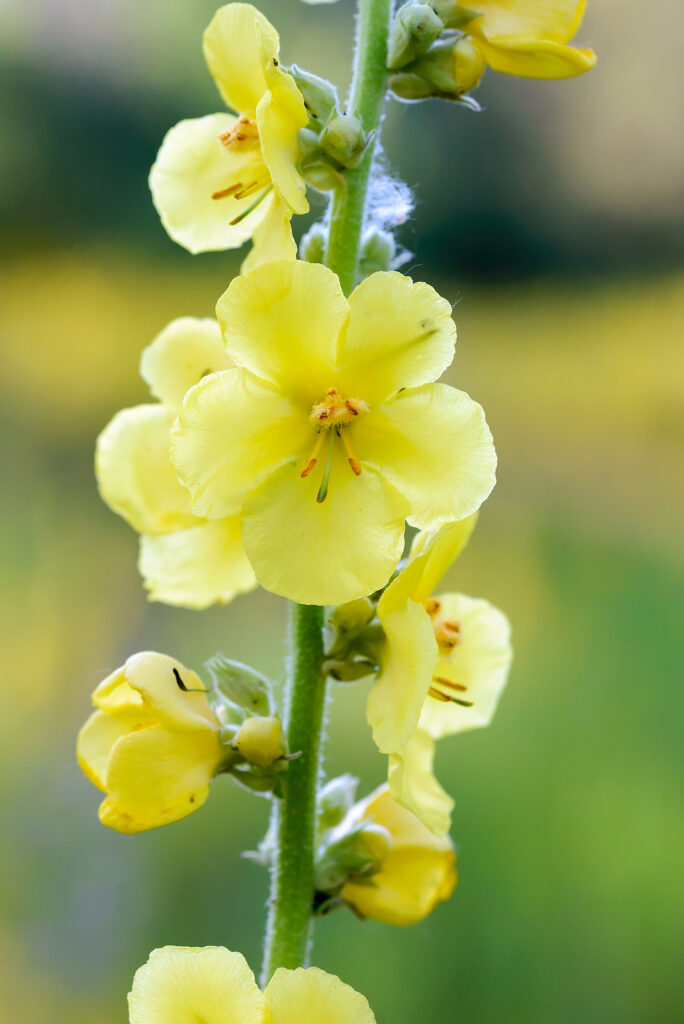Verbascum — commonly called Mullein– produces spire-like bloom stalks covered with small flowers that have a short, tubular base and five spreading petals. Most species have hairy or woolly leaves borne in a large rosette at the base of the plant.
Verbascum flowers are summer blooming. Verbascum grow from 1 to 6 feet (1.8m) tall. Taller mulleins make striking vertical accents. Flowers are usually yellow, but occasionally purple, red, brownish-red, or white.
Verbascum self-sow and some can be weedy. Perennial species are short-lived in hot, humid climates. Verbascum has deep taproots and is happiest left undisturbed once planted.
Verbascum is a genus of about 360 species most of which are biennials, annuals, or perennials. They are native mostly to dry, stony hillsides and wastelands in Europe, North Africa, and parts of Asia.

Get to know Verbascum
- Plant type: Perennial or biennial
- Growing zones and range: Zones 4 to 8 depending on the variety
- Hardiness: Hardy -20°F (-29°C)
- Height and width: 1-6 feet (.3-1.8m) tall stems; plants are 6 to 24 inches (15-61cm) wide depending on the variety
- Foliage: Erect, spirelike bloom stalks, with rosettes of leaves that form at the base of the plant. Both foliage and stems are often covered in wooly hairs.
- Flowers: Nearly flat, five-petaled, circular flowers about an inch (2.5cm) across. Refined species and hybrids have tall spikes, small, saucer-shaped flowers in shades of yellow, pink, purple, or white.
- Bloom time: Early to late summer depending on the variety.
- Uses: Several refined species and hybrids are good for border or naturalizing; taller ones make striking vertical accents; Common Mullein, a biennial weed, is good in country pastures.
- Garden companions: Common monkshood (Aconitum napellus)
- Common name: Mullein
- Botanical name: Verbascum
- Family name: Scrophulariaceae
- Origin: Dry hillsides and open woodland in Europe, North Africa, and Western to Central Asia
Where to plant Verbascum
- Plant Verbascum in sun.
- Plant Verbascum in well-drained, slightly alkaline soil.
Verbascum uses and companions
- Verbascum is suited for growing in a large border or for naturalizing in a wild or woodland garden.
- Plant Verbascum in groups for vertical effect in midground beds and borders.
- Good garden companions for Verbascum include Achillea, Artemisia, Limonium latifolium, Lychnis coronaria, Oenothera, Verbena rigida.

When to plant Verbascum
- Sow biennial and perennial Verbascum in late spring or early summer.
- Set container-grown plants in the garden in spring or autumn.
Planting and spacing Verbascum
- Space Verbascum 6 to 24 inches (15-61cm) apart depending on the variety.
- Leave spikes of biennial Verbascum in place for reseeding.
- Verbascum have deep taproots and are happiest if left undisturbed once planted.
- Verbascum plants self-sow.
How to water and feed Verbascum
- Give Verbascum moderate water.
- Established Verbascum tolerates dry soil.
- Fertilize established Verbascum in spring with an all-purpose organic fertilizer.

How to care for Verbascum
- Cut off spent flowers from perennial Verbascum to encourage a second round of blooming.
Verbascum pests and diseases
- Verbascum can develop mildew, leaf spot, and rot.
- Verbascum is susceptible to attack by nematodes.
Verbascum propagation
- Verbascum seeds germinate in 15 to 20 days at 68° to 86°F (20°-30°C).
- Sow seeds of biennials and perennials in containers in spring or early summer.
- Divide perennial Verbascum in spring.
- Take Verbascum root cuttings in late fall or winter.

Verbascum varieties to grow
- Verbascum blattaria, Moth Mullein, biennial, low clumps of smooth, dark green, cut or toothed leaves. Purple-centered, pale yellow or white flowers on stems 1.5-2.5 feet (.5-.8m) high.
- V. bombyciferum, purple stamens in mid-to-late summer. 3 feet (.9m) tall. Leaves to 6 inches (15.2cm) long. Zones 4 to 9. V. chaixii f. album has white flowers; Zones 5 to 9.
- V. chaixii, Chaix mullein, a perennial, has 1-inch (2.5cm) wide yellow blooms with fuzzy Turkish mullein or Arctic Summer, a biennial (though it may live longer), forms foot high (.3m), wide rosettes of wooly, silver-white, oval leaves and spikes of bright yellow summer flowers; stems to 6 feet (1.8m) tall or more. Zones 4 to 8.
- V. dumulosum, perennial, dwarf to 1 foot (.3m) high, with velvety white leaves and short, branched spikes of purple-centered lemon-yellow flowers. Hybrid ‘Letitia’ has a longer bloom season than the species.
- V. hybrids, perennials. These include the Cotswold and Benary hybrids. Flower spikes in white, cream, and shades of pink or purple are carried on 3-4 feet (.9-1.2m) stems. Named selections in separate colors exist, such as the popular ‘Pink Domino’.
- V. olympicum, perennial. Large white leaves with soft, downy hairs from a rosette to 3 feet (.9m) across. Many stems to 5 feet (1.5m) high carry bright yellow flower spikes. Zones 6 to 8.
- V. phoeniceum, Purple mullein, blooms from late spring through early summer with purple, pink, or white flowers. 4-5 feet (1.2-1.5m) tall. Zones 4 to 8.
- ‘Gainsborough’, a hybrid, has pale yellow flowers from early to late summer. To 4 feet (1.2m) tall. Zones 5 to 9.
- ‘Jackie’, a hybrid, has peach-pink blooms in summer. 18 inches (45.72cm) tall. Zones 5 to 9.
- ‘Summer Sorbet’, a hybrid, has rose-pink flowers in summer. 2 feet (.6m) tall. Zones 5 to 9.















